Aloe vera plants are easier to care for than most people think, and they can grow very well both indoors and outside.
The key is to neglect your plant. Yes, that’s right, just ignore it. Well, you can’t ignore it forever, but the biggest mistake people make is giving it too much attention. This usually results in what I call “killing it with kindness”.
In this detailed guide, I will show you all you need to know: from water, light, and soil, to pest control, fertilizer, and much more.
Quick Aloe Vera Care Overview
| Scientific name: | Aloe vera |
| Classification: | Succulent plant |
| Common names: | Medicinal Aloe |
| Hardiness: | Zones 9-11 |
| Temperature: | 60-85°F |
| Flowers: | Yellow, can bloom year round |
| Light: | Full sun to partial shade |
| Water: | Allow soil to dry out, do not overwater |
| Humidity: | Little to none |
| Fertilizer: | General purpose plant food in spring and summer |
| Soil: | Fast-draining, sandy or gritty soil |
| Common pests: | Mealybugs, scale |
Information About Aloe Vera Plants
Aloe vera, or medicinal aloe, is best known for the healing qualities of the gel. It is very common, and just one of hundreds of different species in the Aloe genus of plants.
This popular succulent is a perennial that’s native to the Arabian Peninsula, but these days it is grown all over the world. If you live in a warm enough climate you can plant it in your garden, otherwise it makes a great houseplant.
Whether you want to grow it for the medicinal benefits, or you simply love the look of the spiky leaves, it’s definitely one that you’ll be able to enjoy for many years to come. My aloe vera plant is over 20 years old, and it’s still growing strong.
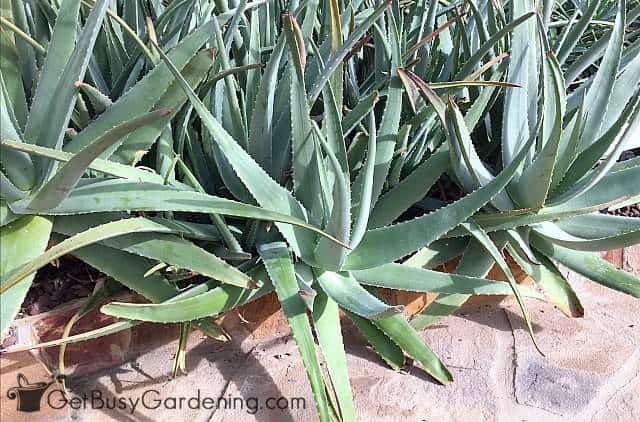
Aloe Vera Plant Benefits
Most people are already very familiar with the medicinal and healing qualities of aloe vera plants. The gel is used in everything from skin and hair care items, to drinks, supplements, and food products.
You can harvest the leaves and gel from your plant and apply it to relieve minor burns and cuts. Or use it to make your own soaps, lotions, and other skin care products if you want.
Another great benefit that many people don’t know about is that growing aloe vera indoors helps to purify the air in your home.
Related Post: How To Store Aloe Vera (Leaves Or Gel)
Where To Grow Aloe Vera
Whether you grow your aloe vera indoors or outside depends on where you live. But either way, choosing the right location is important for them to thrive.
Hardiness
Aloe vera plants are hardy down to zone 9a, and grow best in arid climates. Though they can handle short bursts of freezing temps, they will eventually die if it stays cold for too long.
If you live in a cooler region, or someplace tropical where it rains a lot, then you must move yours indoors during the winter or wet months.
Location
The best location to grow an aloe vera plant is somewhere sunny and dry. Outdoors, plant it in a spot where the soil is very sandy and well-draining. Indoors place your potted plant in a bright, south-facing window.
Though you could keep it inside year-round, you can put it outside during the hot and sunny months. Just make sure the pot has drainage holes, and bring it back indoors before it drops below 60°F in the fall.
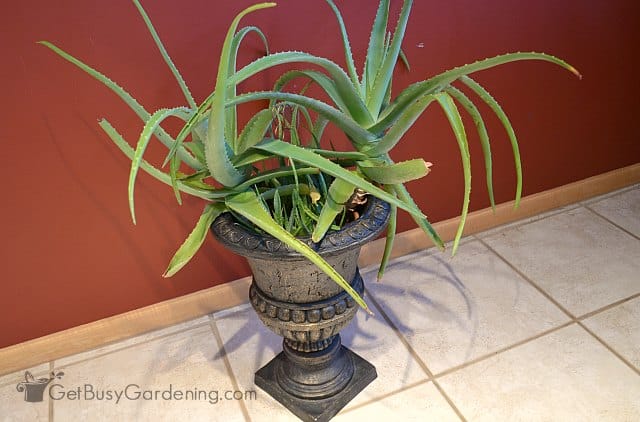
Aloe Vera Plant Care & Growing Instructions
The good news is that aloe vera plants are simple to grow, and they will thrive with minimal care. But, there are a few things you need to do to keep your plant healthy. Follow my tips below for the best success.
Water
The biggest mistake people make when it comes to aloe vera plant care is overwatering. In fact, it’s their #1 killer.
Too much moisture will cause root and stem rot, eventually killing the whole plant from the bottom up. To prevent that from happening, allow the soil to dry out completely between drinks.
Press your finger at least 2 inches deep to make sure it’s completely dry before watering again. If you struggle with this, I highly recommend getting a moisture gauge to help you get it right.
Learn everything you need to know about how to properly water your aloe vera plant here.
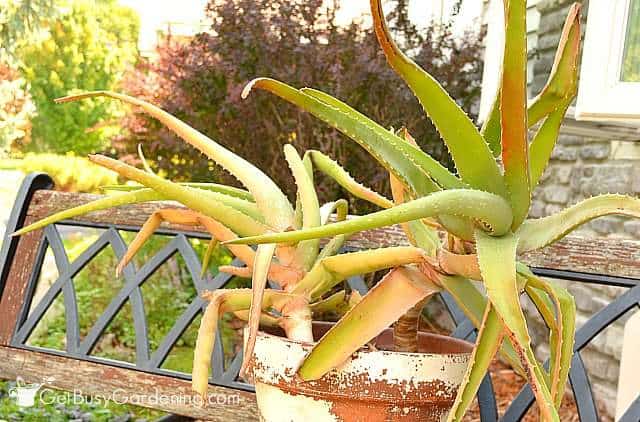
Light
Though they will tolerate partial shade outdoors, aloe vera grows best in a full sun location. If it gets enough sunlight, the leaves can turn a lovely shade of pink, and tall, yellow flower spikes will form.
On the other hand, if they don’t get enough, the plant will become tall and leggy over time. This can be a challenge indoors, so put it in a sunny south-facing window. If your home is too dark, then you should definitely get a grow light.
Related Post: How To Make DIY Aloe Vera Gel At Home
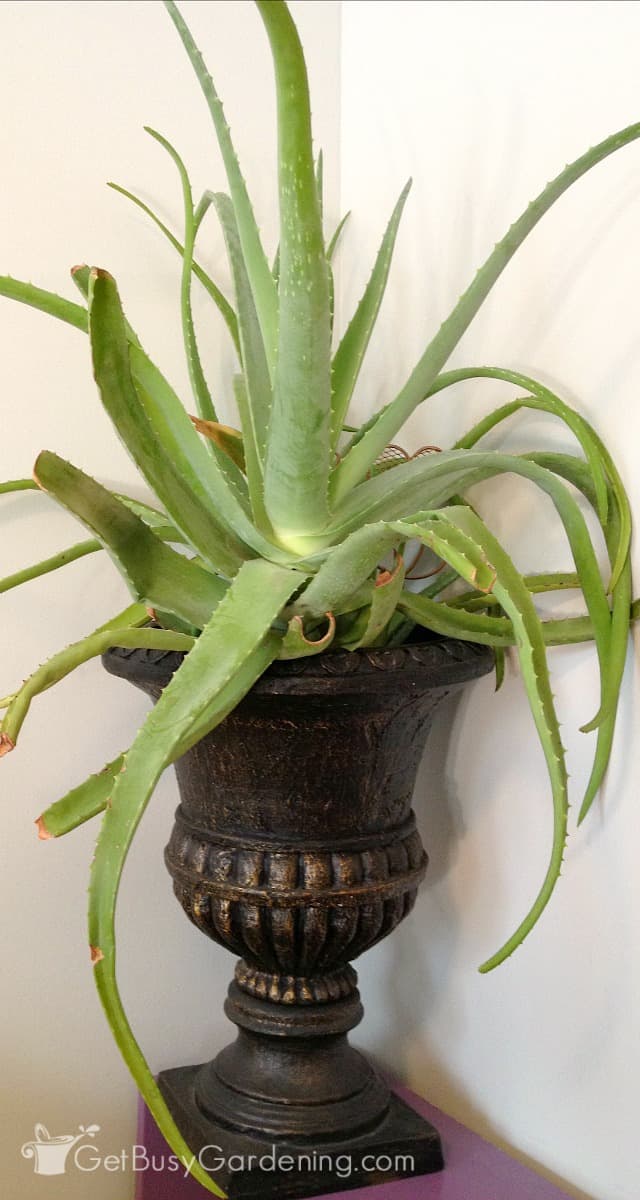
Soil
The best soil for aloe vera is a loose medium that drains very quickly. Use a sandy potting soil, or you could try a gritty mix if you tend to overwater.
I like to make my own, using a mix of perlite or pumice, coarse sand, and regular potting soil, which tends to be cheaper than buying the commercial stuff.
Related Post: How To Make Your Own Succulent Soil (With Recipe)
Repotting
The good news is that you won’t need to repot your plant very often, they like to be root-bound. When the time comes, use a container with drainage holes in the bottom, and only go up one or two sizes.
Planters made out of unsealed terracotta or clay are the best for growing aloe vera, and will wick water out of the soil, helping it dry out faster. Get my step by step instructions for how to repot your aloe vera plant here.
Fertilizer
Aloe vera plants don’t really need to be fertilized. But it will help encourage faster growth and blooming. I recommend using organic products rather than chemicals, especially if you plan to harvest the gel.
Apply a general purpose liquid monthly, or top-dress with slow-release granules once or twice during spring and summer.
Aloes go into a state of dormancy in the winter, and will hardly grow at all. So, don’t feed your plant during the fall and winter months to let them rest.
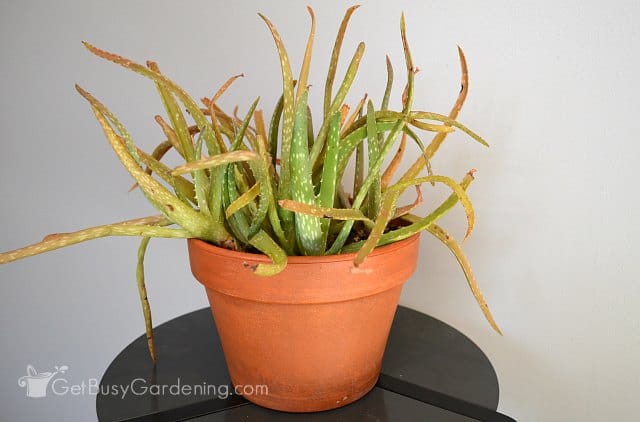
Pest Control Tips
Healthy aloe vera plants rarely have issues with insect pests, but sometimes mealybugs or scale can become a problem.
For small infestations, use a cotton swab soaked in rubbing alcohol to remove any visible bugs. For larger outbreaks, treat your plant with neem oil or an insecticidal soap.
But aloes can be sensitive to certain sprays. So, be sure to test anything you use on a small part of a leaf before treating the whole plant.
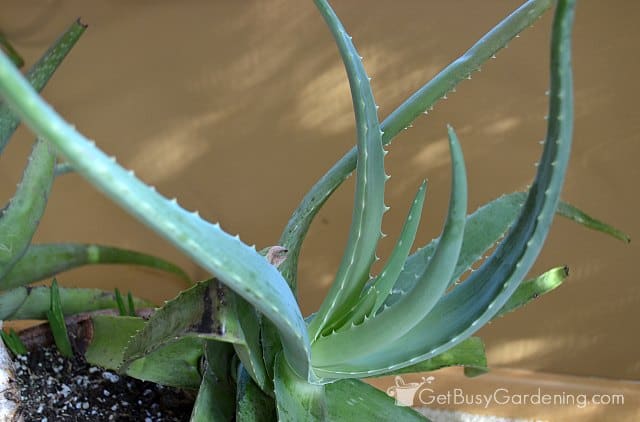
Propagating Your Aloe Vera
It’s easiest to propagate aloe vera plants by division. But if your plant has gotten very long and leggy, and you’re feeling brave, you could try rooting the stem cutting.
This technique can be much more difficult, but it’s fun to try. Simply let the wound cure (dry out) for several days so it calluses over. Then dust it with rooting hormone, and stick it in a dry, sandy medium.
Get my full step-by-step instructions for how to propagate aloe vera by division here.
Troubleshooting Aloe Vera Care Common Problems
Though aloe vera is usually pretty easy to care for, at some point you might start having issues with it. Below are a few of the most common problems, and what to do about them.
Plant Is Tall & Leggy
When an aloe vera grows tall and leggy, that means it’s not getting enough light. They do best with at least 6 hours of full sun per day. If yours is indoors, move it to a south-facing window, or add a grow light.
Mushy Stem
If the stem is completely mushy, that means it was overwatered at some point, and now it’s rotting at the base. Unfortunately there’s not much you can do to fix it.
But you can try saving your plant by cutting it off just above the mushy stem section and rooting it. Make sure you cut off all of the rot though, or it will continue to spread.
Brown Leaves Or Tips
If the brown leaves are drying out and shriveling up, that usually means your aloe vera is not getting enough water. In that case, you can just prune off the dead leaves and water it a little more often.
But if the leaves are mushy and brown, then it’s probably from too much moisture or humidity. So check the soil to make sure it’s not wet, then slow down on watering.
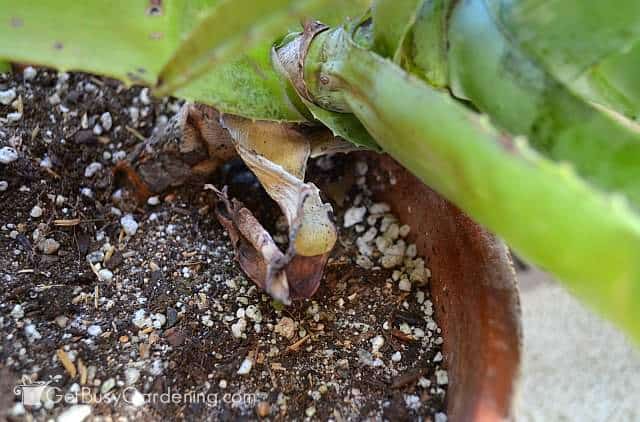
FAQs
Aloe veras can grow pretty fast outdoors in the right climate, but are much slower indoors. If you want yours to grow faster, try putting it outside during the summer, and give it some organic fertilizer.
Leaving the brown tips on your aloe vera won’t hurt the plant. But you can prune them off at any time if you don’t like the way they look.
A healthy aloe vera plant has thick, firm leaves that stand up tall and form tight rosettes. They should also be blueish-green in color (though it’s normal for the leaves to turn yellowish, pink, or orange in the full sun).
Caring for aloe vera is very low-maintenance because these tough plants thrive on neglect. Once you get the hang of giving it exactly what it needs, your plant will thrive for decades to come.
If you want to learn all there is to know about maintaining healthy indoor plants, then you need my Houseplant Care eBook. It will show you everything you need to know about how to keep every plant in your home thriving. Download your copy now!
Share your aloe vera plant care and growing tips in the comments section below.
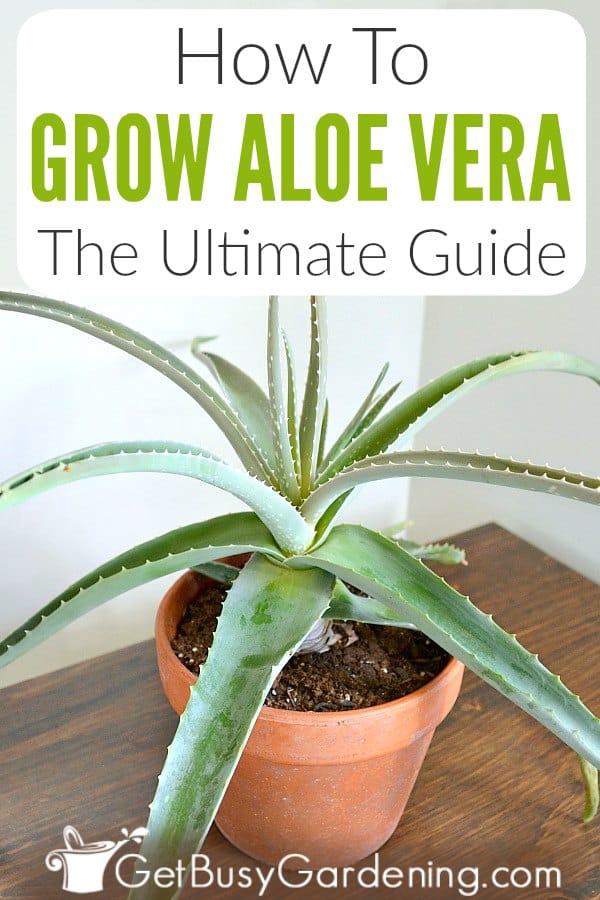
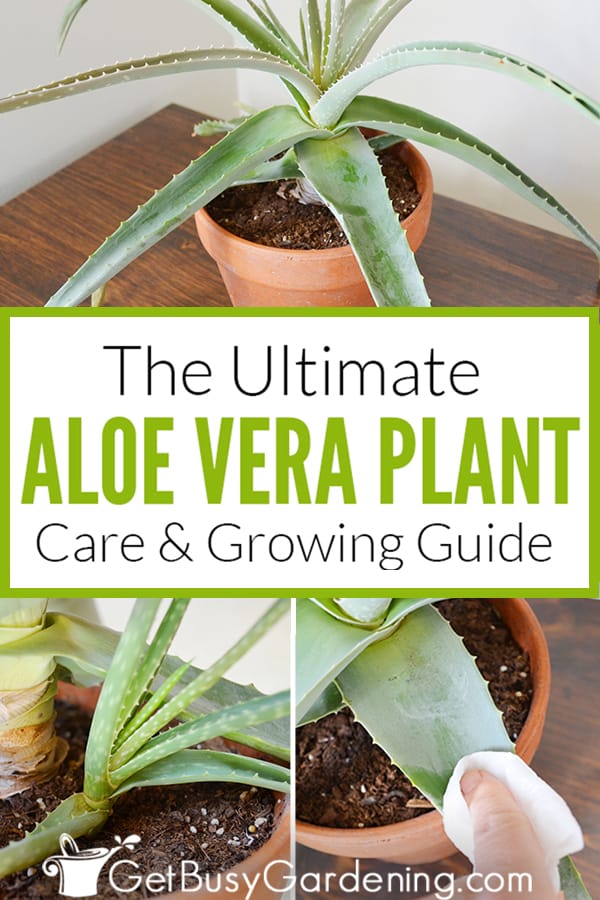
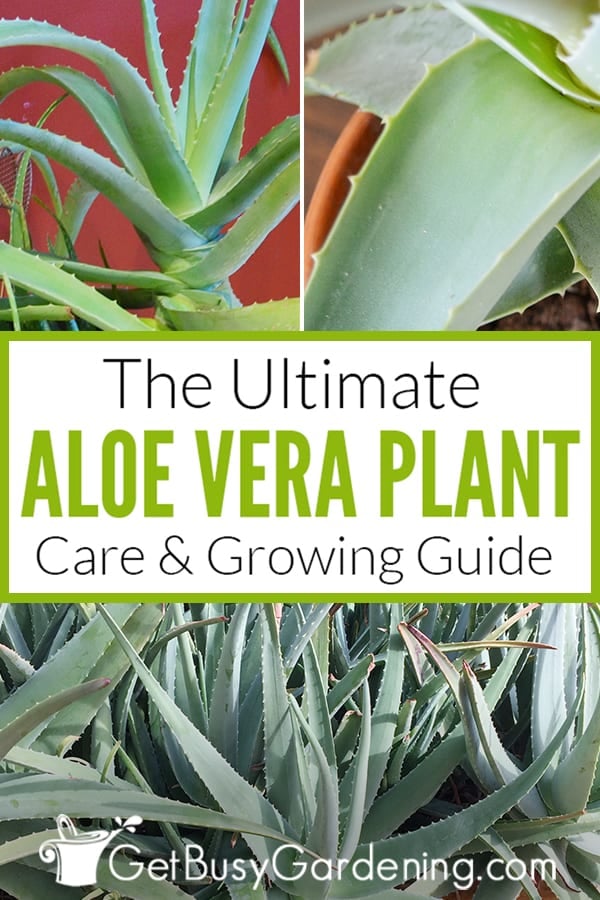
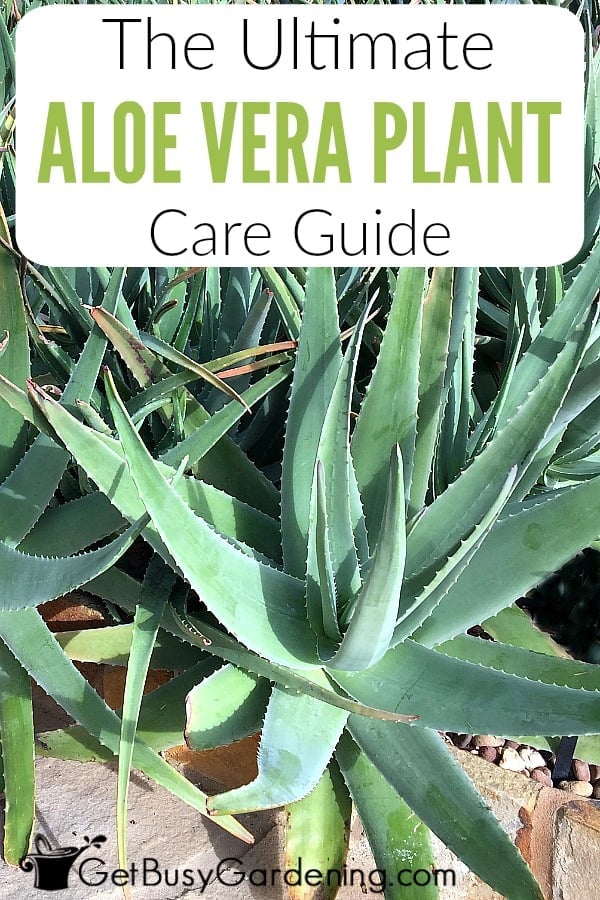
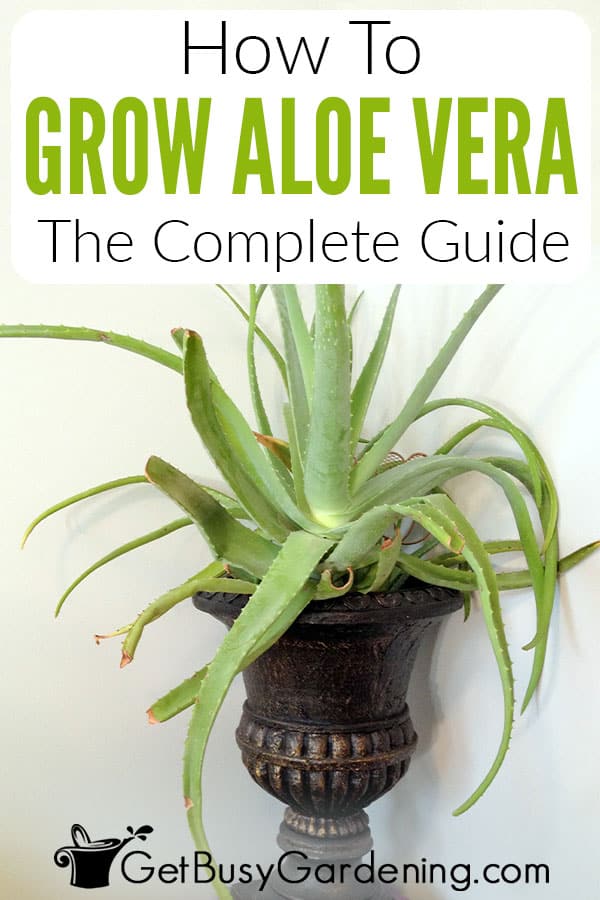
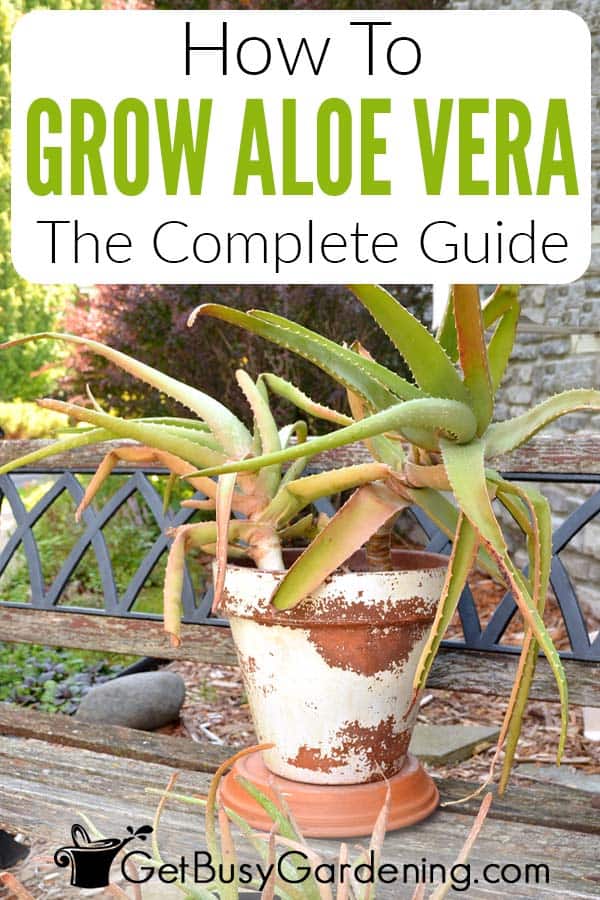
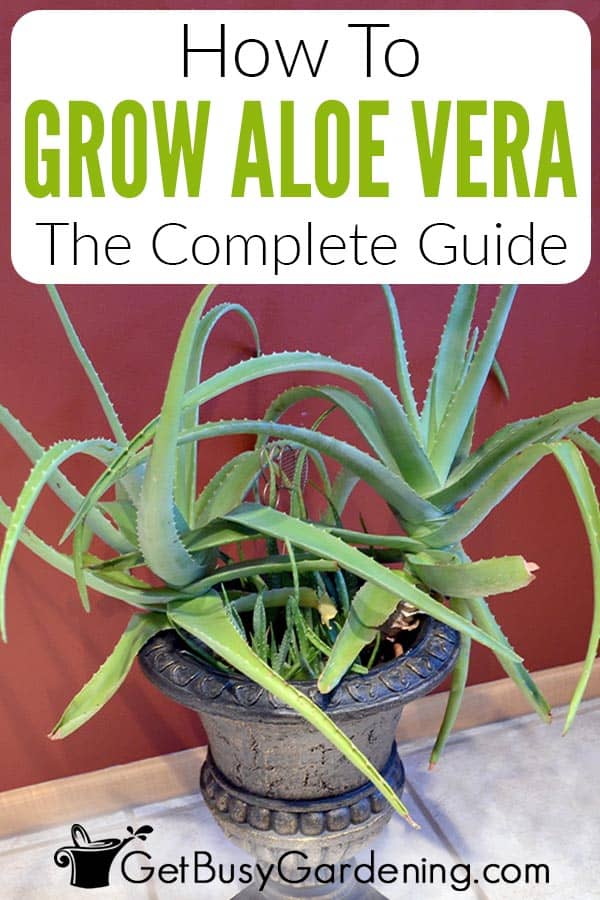
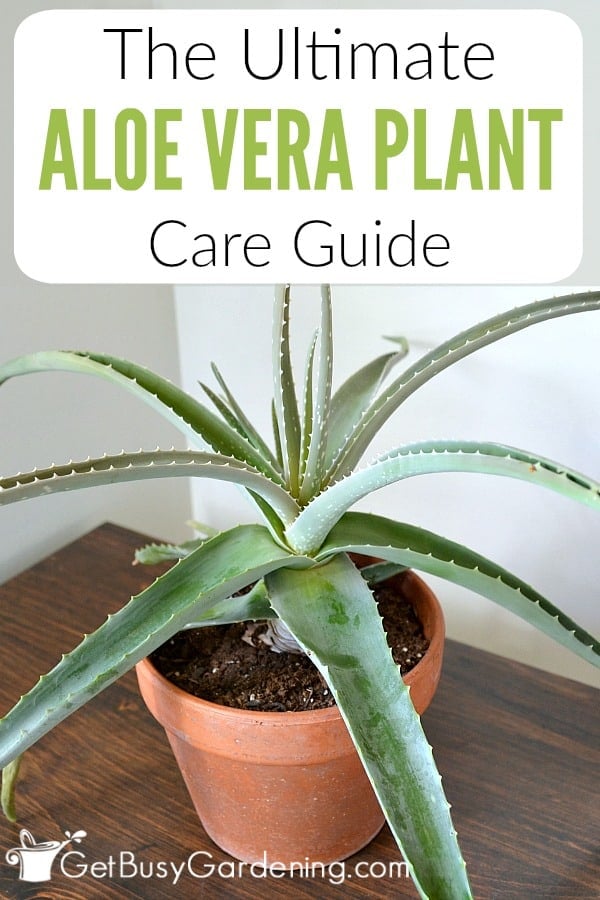
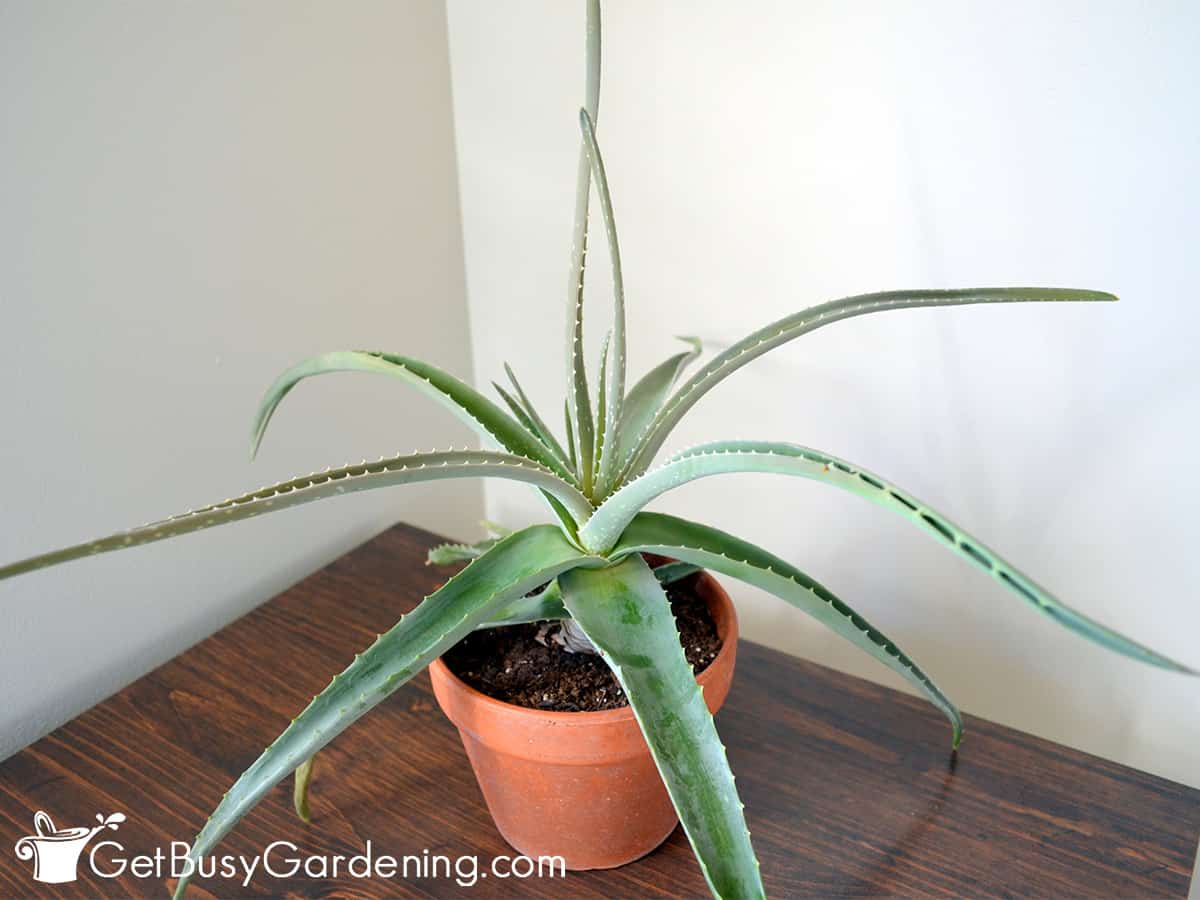




Dionne says
Hi Amy, I just bought an aloe plant that I plan to keep indoors. I live in an apartment with not a lot of light and I live in the midwest. Not a lot of light and we are moving into winter, so my question is do you suggest a grow light?
If so do you have specific recommendations, as there are several types. Also, should it be under constant light or on a rotation? Thanks~
Amy Andrychowicz says
If your aloe vera plant is small, then this grow light would be perfect. I recommend leaving the light on for 12-14 hours a day, ideally. But it will tolerate less light than that during the winter. Don’t feed your aloe, and cut way back on watering it though the winter.
And if you are going to move your plants during the winter, you definitely need to take care that they do not freeze. Even a few minutes in the frigid Midwest winter air could cause major damage, or even death to houseplants. Move them in and out as quickly as you can. Warm up the car before brining your aloe vera outside (or any other houseplant), and make sure you cover your plant completely with a blanket or towel during transport. Then when you get to your new home, bring the plants in first so they’re never sitting in the car.
Dionne says
Great advice! Thanks a bunch.
Amy Andrychowicz says
You’re welcome!
Dan says
My plant leaves look like the are drying up what am I doing wrong
Amy Andrychowicz says
Dried up leaves is common for an aloe plant that’s not getting enough humidity/moisture. You can try watering your aloe a bit more often, or move it to a place that’s a little more humid. Don’t go overboard though, they don’t like a lot of humidity, or to be overwatered. Sometimes it can be a tricky balance.
Danielle says
My aloe has a long stem, when I re-pot do I need to pot deeper to cover some of the stem. My plant is tall and started to tilt at one point.
Amy Andrychowicz says
You sure could do that. If the stem on your aloe vera is super long, you could also think about propagating it at some point (if you’re brave enough to try 🙂 ).
Austin says
I live in Central Texas, and I have several beautiful aloe plants doing very well on my front porch. We live in a duplex, which basically means we have terrible natural light, so I’m hesitant to bring any of them inside (although I’d love to have a few indoors). My question is when it comes to the winter, do I HAVE to bring them indoors? Obviously, we don’t have very intense winters, but it still gets cold, so I wasn’t sure if they’d do alright outside. I also have wandering Jews and a couple of agave (obviously not the same, but nervous about all of them when winter gets here). Any advice would be great!
Amy Andrychowicz says
You certainly don’t need to bring your aloe plant into the house, as long as you live in a warm enough climate. Aloe vera (and both of the other plants you mention) is hardy down to zone 9, which means it can take a little bit of cold in nature. I’m not sure how cold it gets where you live, but, even though they can take a bit of cool weather, it might be a good idea to protect it from frost and freezing temperatures. You could just move it inside during cold nights if you don’t have many of those, otherwise move your aloe indoors for the few weeks/months when you have a cold spell. (p.s. here’s a post about caring wandering jews… Tips For Growing Wandering Jew Plants Indoors)
Alicia says
I have had my plant out side all summer and want to bring it in. I have noticed some flowering plants or other plants I have brought in over the years bring nats. Is there a spray or something I can use on it to make sure I don’t bring these with me I would hate to loose my aloe!
Amy Andrychowicz says
The gnats you are describing are called soil gnats, and they are very common in houseplants. They live in the soil, so I wouldn’t recommend any type of spray. Soil gnats can’t live in dry soil, so keep your aloe vera plant dry through the winter (which is the best thing for the plant anyway). Here’s a post about controlling soil gnats for more details… How To Control Soil Gnats In Houseplants
Adam says
I bought my aloe plant about a year ago. The previous owner had a cat that left bite marks. I thought they’d heal. Should I trim those off?
Amy Andrychowicz says
The wounds on your aloe leaves should seal up and heal, and the plants should recover just fine. If the wounds are showing signs of rot, or the leaves are heavily damaged, then I would trim them off. Otherwise, if the damage is minor, they should be fine.
Adam Owens says
Thank you. I tried them. The brown hole scars were unpleasant to look at. But I did wrap them and put them in the fridge. The have a lot of gel in them.
Amy Andrychowicz says
Perfect!
Sunitha says
Hello, I have just started growing aloevera recently. I cut abt 2 inch from the leave every week for juicing purpose. How long will it take to regrow??? Plz reply
Amy Andrychowicz says
The cut leaves will not regrow. New growth will come out from the top of the plant.
Mary K Priebe says
How do I use Epson Salt in a Aloe Plant?
Amy Andrychowicz says
I do not recommend using epsom salt in an aloe vera plant.
flo thomas says
What am I doing wrong to my aloe plants? I’ve had 4 that have died. I’m careful not to over water, planted them in proper soil and still no success. I just got a couple plants that looked very healthy and within a few days they look sunburned. I’ve moved them from various windows to see what kind of light they need. HELP!
Amy Andrychowicz says
If your aloe plants are getting sunburn, then you definitely need to put them into a shadier spot and slowly acclimate them to a full sun location over time. As for your other aloe plants that have died… can you give me more details? What happens right before they die? Do the leaves start to turn black at the base, and droop/drop from the plant? Does the whole plant collapse and die at once? Do the leaves become shriveled and completely dried out as the plant slowly dies? The #1 killer of aloe plants is overwatering. So, I suspect that’s probably what’s happened to your plants.
Ashley says
What would be the reason for leaves to turn purple?
Amy Andrychowicz says
Aloes can turn different colors in different environments. Red, orange, purple and gray are all pretty common colors that aloe veras can change to. Sudden changes in lighting, watering, feeding, temperature… pretty much any environmental change can trigger the color change. As long as your plant is firm and not mushy, and otherwise looks healthy, then it should be fine. Just be sure that it’s not being overwatered, and that it wasn’t suddenly moved to the full sun and getting sunburn. There are lots of different varieties of aloe plants that come in different colors too, so it may also be that yours isn’t an aloe vera, but some other aloe species.
Denise Brown says
Are there different types of aloe vera plants? I have 2 that I bought that were labeled aloe Vera. One is like what you showed, but the second one is tall with long stems and smooth edges.
Amy Andrychowicz says
Aloe vera is just one species of aloe plant. There are tons of different varieties of aloe plants, but only one that is called “Aloe vera”. Unfortunately, it is very common for other species of aloe plants to be labeled “Aloe vera”, even though they are a different species of aloe.
lahiett says
How do you keep the Aloe Vera leaves clean from dust?
Amy Andrychowicz says
You can use a damp cloth and gently wipe the dust off the leaves on a regular basis. You could also bring your aloe vera to the sink or shower and rinse the leaves, just be careful not to overwater your plant in the process. 🙂
Kathy says
Great article and wonderful photos! Maybe I missed it but, I didn’t see anything about pot size. Do they like to be root bound or have a little room? Thank you.
Amy Andrychowicz says
Great question! My aloe vera loves to be pot bound. The roots don’t get very deep, so I would recommend planting them in a small pot where they have some room to grow, but not too much. Mine has been growing in the same pot for several years. I just slide it out of the pot every few years to remove some of the aloe pups, then plant it back into the same pot, filling in any spaces with fresh soil.
emily says
hello there! my grandparents have an aloe plant that’s over 20 years old and has never been propagated. it has always been an indoor plant. it is turning into a giant monster, about 5 feet wide with a thick spiraling tree-like stem that has moved from the pot to about 2 feet over on the stand it is on. i need to fix it, but i haven’t found anyone whose aloe plant is this much out of control! it’s like a monster plant. please help!
Amy Andrychowicz says
Oh my, that sounds amazing! My aloe vera did the same thing several years ago. I cut the whole top off and propagated it. Yes, I was brave. 🙂 Allow the stem to dry for a few days until the cutting is calloused over. Then dust it with rooting hormone and stick it in a pot filled with a dry sandy soil mix. Don’t water the soil (I can’t stress this enough), but you can mist the cutting once and a while (or put it in a humid location). Leave it alone until you see signs of new growth, which means it’s rooted. It took several months for my huge aloe cutting to show signs of new growth. I left the main stem in the original pot, and it regrew. Now I have two huge aloe vera plants! Good luck, and have fun!
marnie wells says
Hi Anne
My aloe plant has succumbed to some problems this summer. I stripped off the bottom leafs and am now goin to repot. Can I place the stem down in the dirt? Will it root up the sides?
I think it’s going to be too top heave otherwise
Thanks!
Amy Andrychowicz says
Yes, aloe vera stems will grow new roots along the sides if you plant it deeper.
vik says
i have one that is doing the same thing. i topped several of the four foot tall growth back to two feet and planted the other pieces. they “took” well and are doing fine. the problem is getting rid of them. trying to use them as gifts to people who have room to grow. one can only grow so many you know.
MUNEEB says
HI AMY!
I just wanna to ask some question.
1. Can i planted Aloe Vera indoor ?
2. Can i use sand instead of soil to planted Aloe Vera ?
Amy Andrychowicz says
Yes you can grow aloe vera indoors. I mix sand into my DIY soil mix. Here are a few posts that will help…
Tess says
Hi Amy!
I’m so glad I found your article… I live in the Northwest (Tacoma, WA) area and I want to try growing Aloe Vera and a couple other Aloes indoors from seeds… I’m gathering what I need now I.e. – pots, soil, drainage trays for the window sills and full spectrum LED plant lights… Can you please add a section on growing Aloe Vera from seed, I can’t seem to find much info on that.
Thanks, Tess
Amy Andrychowicz says
Hi Tess, I will add it to my list. 🙂 Did you buy aloe vera seeds somewhere, or are you collecting the seeds yourself? Like the parent plant, just be sure to use a sandy soil and don’t overwater the seedlings.
Carla says
This article is soooo informative, I now know that I can really take care of my Aloe AND help it to thrive. Thank you!
Amy Andrychowicz says
Awesome, you’re welcome! 🙂
Heather says
I have almost 30 aloe plants in my house love them! 5 of them are b/w 12-15 inches high. They get good amounts of sun, but still growing tall. The leaves are thick and strong. One of my largest ones grew a tall stem and bloomed yellow flowers! I didn’t know they did this. I forgot about one of my sloe plants. I left it on a window sill in another room and the curtains were shut. I must have left it 3+ months. I thought, for sure, it was dead. Nope! Healthy and has pups! Also, it too is growing a stem and has flower buds on it!
Amy Andrychowicz says
Cool! Yes, all types of aloes bloom. Some bloom more often than others. I have a few that bloom several times a year, and others (like my aloe vera) that have never bloomed.
Sss says
Can you tell me types of aloe vera? And which one is usefull in cosmetics?
Amy Andrychowicz says
Aloe vera is the type that is useful in cosmetics.
jannine says
Aloe Barbadensis…those grow big
Roseann Hampton says
I grow my plants outside. Because the summer sun can be so intense in the Houston area, mine seem to do better in morning sun with afternoon shade.
Amy Andrychowicz says
Thanks for the tip!